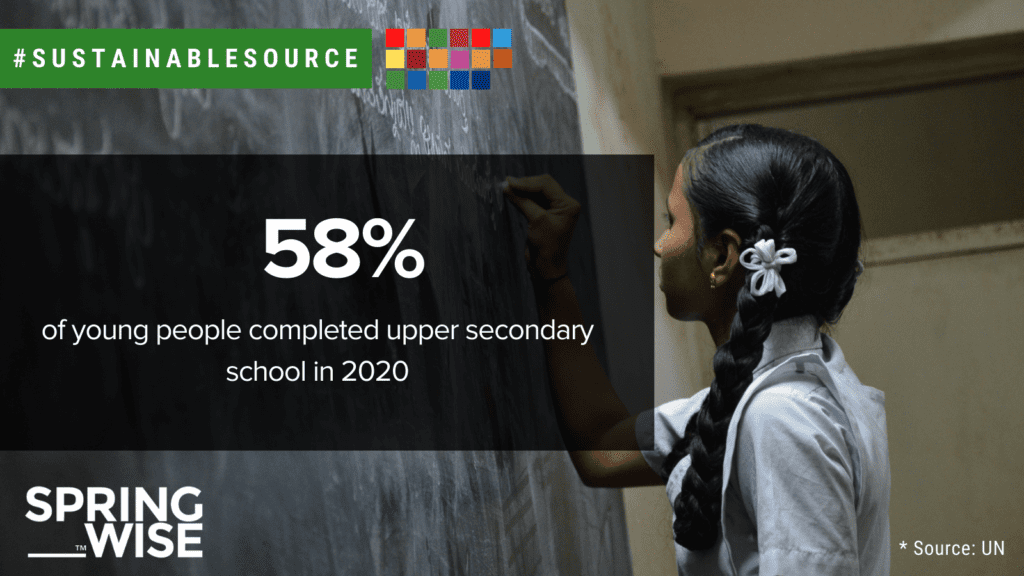There is no shortage of research demonstrating how vital education is for a wide variety of social and economic outcomes. For example, one additional school year can increase a woman’s earnings by 10 to 20 per cent, and each year of education reduces the risk of conflict by 20 per cent.
Before the COVID-19 pandemic, the percentage of young people completing upper secondary school increased from 54 per cent in 2015 to 58 per cent in 2020. While these figures demonstrate progress, this rate of improvement actually represents a slowdown from the preceding five-year period. And even before the pandemic, projections showed that only 60 per cent of young people would be completing upper secondary education in 2030, indicating a pronounced deceleration in educational progress.
If progress was slowing even before COVID-19 swept the globe, early indications suggest that the pandemic has had a significant detrimental effect on educational outcomes. Figures from UNICEF show that school closures have resulted in 2 trillion hours of lost in-person learning globally. And the impact is likely to be felt the most in low-income countries, with the United Nations expecting a spike in school drop-outs in the coming years.
Against this backdrop, efforts to improve access to education for all age groups are more important than ever, and innovation can play an important role.
Access to schooling
Access to schooling is an obvious place to start a discussion of innovation and education. But the years before a child reaches school age are particularly important for their development. Despite this, only one in five children are enrolled in pre-primary education in low-income countries. In Uzbekistan, educational authorities are using converted buses to bring pre-school classes to the most remote communities.
Participation rates improve once a child reaches primary school age, even in low-income countries. Nonetheless, access to schools can be challenging in many regions, with children required to walk for hours to attend lessons. A non-profit in Madagascar is addressing this issue with 3D-printed schools that can be located closer to homes.
University-level education is the most exclusive of all, with affordability acting as a key barrier to access. For example, in some Southeast Asian countries, the average cost of a university education is nearly double GDP per capita. A Singapore-based startup aims to provide students with affordable financing options by partnering directly with universities to offer subsidised installment plans.

Diversity and inclusion
Education is not only about ensuring children attend class, it’s also about creating an environment where students from all backgrounds can thrive. School can be particularly challenging for migrant children who face cultural as well as language barriers. For example, unaccompanied asylum-seeking children are over three years behind non-migrant pupils on average. One Danish startup has developed a language-learning app that helps migrant children navigate differences between their own culture and the culture of their new home.

Learning differences
Inclusion is also of critical importance for students with learning differences. According to UNICEF, only 36 per cent of adolescents with disabilities complete lower secondary education. In response, innovators are developing tools that are tailored to the needs of non-traditional learners. One personalised learning platform offers tailored programmes, and connects students with educators who can provide individualised support. Meanwhile, another startup has developed a voice-based learning app that is specifically designed for those with reading and writing difficulties.

Adult learning
Education isn’t only about children. Target 4.4 within SDG 4, focuses on the importance of technical and vocational skills for youth and adults. On-the-job training is one focus for innovators. For example, a Paris-based startup has leveraged artificial intelligence to develop a human-first employee learning platform.
Adult learning is particularly important for those who find themselves displaced as a result of wars and natural disasters. One language-learning platform is connecting refugees and those from other marginalised groups with employers in the digital economy. The goal is to help disadvantaged candidates break into a sector they might have previously considered out of reach.
Words: Matthew Hempstead
Know more innovations supporting SDG 4? Spread the word!
Sign up to the Sustainable Source newsletter to receive regular updates on the green innovations that matter and to get our insights into innovation and the SDGs direct to your inbox.
21st June 2022

